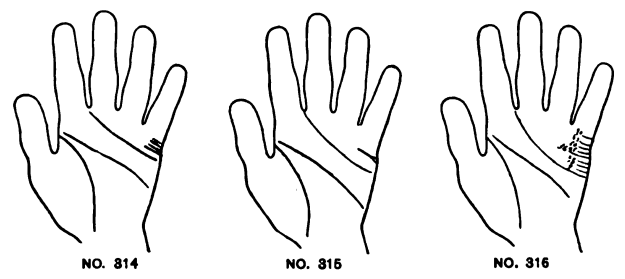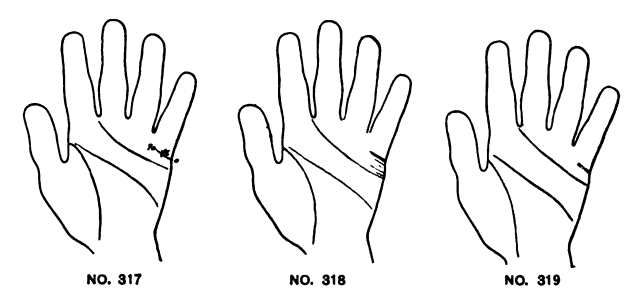How to Read the Affection Lines
Table of Contents
If many lines of Affection are present (314) the subject is susceptible in affairs of the heart, more or less seriously so as the lines are strong or weak.

These lines of Affection are always cross-lines, and start from the outside of the hand, sometimes at the back cutting around into the Mount of Mercury.
If only a single line is seen, there will be but one deep affection.
A line beginning with a fork (315) shows that the affection is of unusual strength, the two lines of the fork having united to form a single line, producing the effect of two Currents turned into one, which thus takes on double strength.
There are 2 ways to read the age on lines of Affection:
- What age the affection occurs
Use the Heart line as a lower mark, and the top of the Mount of Mercury as the upper.
This space must be subdivided into the average years of life, bringing the middle of the Mount at 36, and the top at 70 years. Thus:
- all lines of Affection appearing before the middle of the Mount occur before 36 years old.
- those appearing beyond the centre of the Mount occur after 36.
The scale (316) will be found approximating the correct ages and accurate enough for all general purposes. It can, however, be still further subdivided if more exact dates are desired.

- How long it lasts
Measure the line from its beginning to its termination. In this way also, events in the course of an affection are often recorded.
The scale of measurement for such readings begins with the starting of the line and ends with its termination, the line to be divided in the middle as age 36, and 70 as the end.
The intervening years can be subdivided as minutely as is necessary in order to reach the age of any markings on the line which is desired (317).
The longer the line of Affection, the longer the affection continues.
- When a number of lines are seen, the duration of each affair may be estimated by the length of the several lines.
- The age at which each occurs is read from the Mount subdivided
- The duration is read from the length of the line.
By this method, read:
- the number of strong attachments the subject has had and
- how long each one lasts
By the longest and deepest line, determine which one has been deeper than the rest (318).
- This marking will indicate several deep attachments, finally culminating in the all-absorbing affection shown by the deep line.
If two lines run alongside of each other and are of the same depth (319) the subject has loved two persons equally well at the same time.

In every case, the highest line of Affection is the last one which has occurred.
Any lines lower than it will record former affections.
If a number of lines be seen, the upper one a deep line, but one of the early lines deep at the end, it indicates that the early love has never entirely disappeared (320).
From every combination of lines:
- select the strongest attachments from the deepest lines, and
- determine by the character of the lines how completely this attachment has passed away.
If the last Hue be a thin one, and yet by its length and confirmatory signs proves to be the Marriage line, and if a stronger line lie close under it (321) the subject has married for convenience, or money, but not from strongest love.
If the lines of Affection are thin in proportion to other lines in the hand, the subject has no real strong affections.
- He has a brotherly affection for his wife, but love will not be the absorbing passion.
- These subjects are indifferent to affection and are cold.
- If they have many lines of Affection, are apt to be flirts.
- If such Subjects are handsome, they break many hearts.
If in a woman’s hand the lines of Affection are broad and shallow, or chained, the subject is still more indifferent.
- She will lead suitors on for the pleasure of disappointing them.
- These subjects have no real affection, and are selfish, cold, and cruel.
White color will add to the coldness of both of these latter lines.
The deep and well-cut lines show deep, lasting affection.
- These are strengthened if they be also pink or red in color.
- Such subjects love ardently, constantly, and make sacrifices for those they love.
- It is their pleasure and pride to be constant and true.
If such a deep line ends without fault or break, the subject will pursue a life of ardent attachment, of reliability and steadfastness, from beginning to end.
If the line start deep and gradually grow thin, the subject will gradually lose the strength of his attachment (322).
If the line start thin and gradually become stronger, the subject will grow stronger in his attachment (323).

If an island appear on the line of Affection, there will be some unhappiness during the course of the affection (324).
If the line of Affection is composed of islands, the subject will never have affection enough for anyone to marry him (325).
If a cross be seen on the line of Affection there will be a serious impediment to the affection (326).

If this line end in a star the affection will terminate in an explosion (327).
If a line of Affection send a branch into the Mount of Apollo which ends in a star, the subject will have an affection for someone brilliant and famous (328).